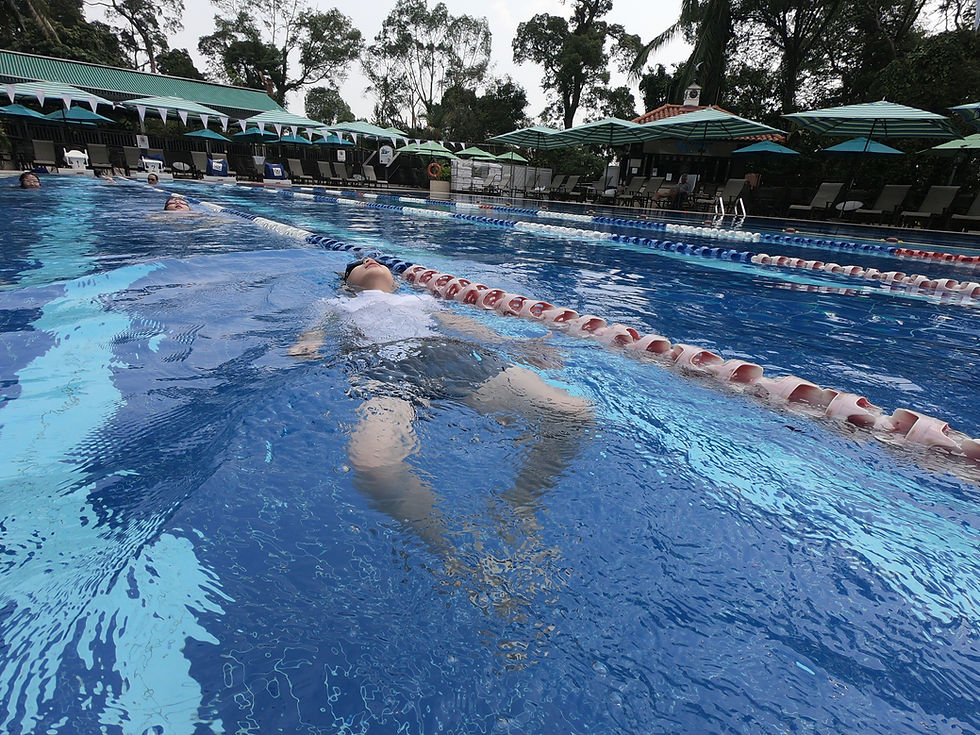3-Step Progression Drills for Beginner Butterfly Swimmers
- SG Sink Or Swim

- Oct 1
- 4 min read

Simple, Safe, and Successful — Build Confidence and Coordination Without Overwhelm
Butterfly is often seen as the most challenging of the four competitive strokes — a whirlwind of undulation, timing, and power that can intimidate even experienced swimmers. But for beginners, the key isn’t to “do butterfly” right away. It’s to build it piece by piece, in a way that feels safe, manageable, and even fun.
With the right progression, butterfly transforms from a source of frustration into a joyful expression of rhythm and flow. This guide offers a clear, effective 3-step progression designed specifically for beginner butterfly swimmers (ages 8+ or adult learners) to develop body awareness, core-driven movement, and stroke confidence — without fear or fatigue.
🦋 Why a 3-Step Approach Works
Beginners often fail at butterfly because they try to do everything at once: kick, pull, breathe, and recover — all while fighting to stay afloat. This leads to:
Knee-driven “bicycle” kicks
Breath-holding and panic
Collapsed body position
Early burnout
By breaking butterfly into three foundational phases, swimmers master one skill before adding the next. This builds neurological pathways, reduces cognitive load, and creates a sense of achievement at every stage.
“You don’t learn to fly by flapping your arms. You learn by feeling the wave.”
🌊 Step 1: Master the Undulation — “Wave Before Arms”
Goal: Develop a core-initiated dolphin motion — the true engine of butterfly.
✅ Key Focus:
Movement starts in the chest, not the knees
Smooth, wave-like motion through hips and legs
Streamlined body position
🛠️ Drills:
Streamline Dolphin Kicking (Underwater)
Push off wall in tight streamline
Perform 3–5 dolphin kicks underwater
Emphasize: Chest down → hips up → legs follow
Glide to stop; repeat 6–8 times
Vertical Dolphin Kicking
In deep water, cross arms over chest
Kick to keep chin above water
Keep knees underwater during recovery
Builds power and rhythm without wall dependence
🎯 Cue: “Press your chest down like you’re nodding ‘yes’ — let your hips follow.”💡 Tip: Use short fins to help feel the undulation. Remove once rhythm is established.
🖐️ Step 2: Add Arm Movement — “Recovery Without Breath”
Goal: Introduce arm recovery and entry while removing breath stress.
✅ Key Focus:
High-elbow, relaxed arm recovery
Fingertips-first entry
Synchronization with body wave
🛠️ Drills:
One-Arm Butterfly (No Breath)
Keep one arm extended in streamline
Other arm performs full recovery and pull
Head stays down — no breathing
Focus on “throwing” the hand forward, not swinging
Snorkel Butterfly
Use a front-mounted snorkel
Swim full butterfly motion with steady breathing
Eliminates timing pressure — lets swimmer focus purely on stroke mechanics
🎯 Cue: “Elbow leads, hand follows. Enter like a raindrop — quiet and smooth.”⚠️ Avoid: Straight-arm recovery or wide “windmill” swings.
🌬️ Step 3: Integrate Breathing — “Timing the Lift”
Goal: Sync breath with the natural lift of the pull — without disrupting body line.
✅ Key Focus:
Breathe forward, not up
Quick inhale, immediate submersion
Maintain undulation through breath
🛠️ Drills:
“Breathe Every 2nd Stroke”
Swim butterfly, breathing only every other arm cycle
Reduces oxygen demand and builds timing confidence
Prevents breath-holding on non-breathing strokes
Pull-Breathe-Kick-Glide Sequence
Break the stroke into parts:
Pull hands back → breathe (eyes forward, chin low)
Snap hands together → kick
Recover arms → submerge head
Glide 1–2 seconds
Practice slowly at first, then increase tempo
🎯 Cue: “Breathe through the keyhole — small, fast, forward.”💡 Tip: Place a tennis ball under the chin during drills to prevent lifting.
🎮 Bonus: Fun Games to Reinforce Learning
“Dolphin Race”: Who can glide farthest after 3 underwater kicks?
“Mirror Fly”: Instructor demonstrates slow-motion butterfly; swimmers copy like a mirror.
“Bubble Challenge”: Blow steady bubbles underwater during glide — no gasping!
📅 Sample Beginner Butterfly Session (30 Minutes)
Warm-Up (5 min):
200m easy freestyle or backstroke
4 x 25m flutter kick with board
Step 1 – Undulation (10 min):
6 x 15m Streamline Dolphin Kicks (underwater)
4 x 30s Vertical Dolphin Kicking
Step 2 – Arms (8 min):
4 x 25m One-Arm Fly (no breath)
4 x 25m Snorkel Fly (focus: high elbow recovery)
Step 3 – Breathing (5 min):
4 x 15m Full Fly (breathe every 2nd stroke)
2 x 25m Pull-Breathe-Kick-Glide (slow motion)
Cool-Down (2 min):
100m easy backstroke + big smile!
💬 Coaching Cues That Build Confidence
🦋 “Fly from your chest — not your knees.”
🌊 “Your body is a wave — not a seesaw.”
🖐️ “Throw your hands — don’t swing them.”
🌬️ “Breathe like a spy — low, quick, forward.”
🧱 “Glide like a missile — not a noodle.”
⚠️ Safety & Encouragement Tips
Never force submersion — let comfort grow naturally
Celebrate micro-wins: “You kept your head down!” “Your kick was smooth!”
Keep distances short (15–25m) to prevent fatigue and form breakdown
Always end on success — even if it’s just a great streamline glide
Final Thoughts
Butterfly isn’t about strength. It’s about rhythm, trust, and flow. When taught in the right sequence — wave first, arms second, breath third — beginners don’t just learn a stroke. They discover a new way to move through water with grace and joy.
So go slow. Be patient. Celebrate every ripple of progress.Because the child (or adult!) who learns to fly on their own terms……becomes the swimmer who never fears the water again.
Wave. Reach. Breathe. Glide.
Butterfly isn’t a test — it’s a dance. And everyone deserves to learn the steps. 🦋💙





Comments